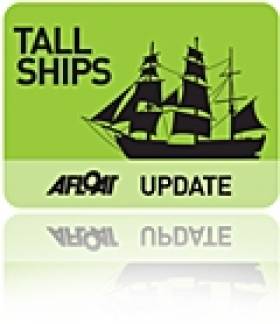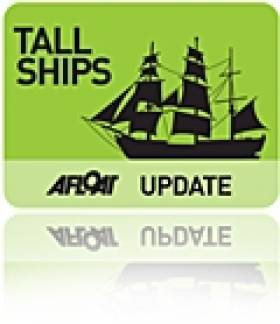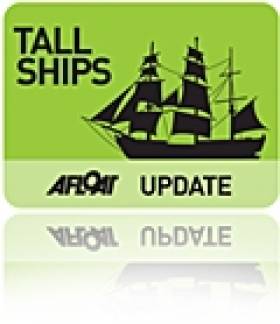Displaying items by tag: Christian Radich
A New Tall Ship For Ireland? It's Back to The Future
#tallship – The Tall Ships return to Ireland in spectacular style this summer with a major fleet assembly in Belfast from Thursday 2nd to Sunday 5th July for the beginning of the season's Tall Ships Races, organised by Sail Training International. The seagoing programme will have a strong Scandinavian emphasis in 2015, with the route - some of which is racing, other sections at your own speed – starting from Belfast to go on Aalesund in western Norway for 16th to 18th July, thence to Kristiansand (25th to 28th July), which is immediately east of Norway's south point, and then on to conclude at Aalborg in northern Denmark from 1st to 4th August.
But before leaving Northern Ireland with the potentially very spectacular Parade of Sail down Belfast Lough on Sunday July 5th, the celebrations will be mighty. The fleet's visit will be the central part of the Lidl Belfast Titanic Maritime Festival, which will include everything from popular family fun happenings with concerts and fireworks displays – the full works, in other words – right up to high–powered corporate entertainment attractions.
As for the ships, there will be more than enough for any traditional rig and tall ship enthusiast to spend a week drooling over. In all, as many as eighty vessels of all sizes are expected. But more importantly, at least twenty of them will be serious Tall Ships, proper Class A square riggers of at least 40 metres in length, which is double the number which took part in their last visit to Belfast, back in 2009.
That smaller fleet of six years ago seemed decidedly spectacular to most of us at the time. So the vision of a doubling of proper Tall Ship numbers in Belfast Harbour is something we can only begin to imagine. But when you've a fleet which will include Class A ships of the calibre of the new Alexander von Humboldt from Germany, Norway's two beauties Christian Radich and Sorlandet, the much-loved Europa from the Netherlands, George Stage from Denmark, and the extraordinary Shtandart from Russia which is a re-creation of an 18th Century vessel built for Emperor Peter the Great, you're only starting, as that's to name only six vessels – what we'll be seeing will be a truly rare gathering of the crème de la creme.
So although it would be stretching it to think that a small country like Ireland should aspire to having a major full-rigged vessel, we mustn't forget that for 27 glorious years we did have our own much-admired miniature Tall Ship, the gallant 84–ft brigantine Asgard II. Six-and-a-half years years after her loss, it's time and more for her to be replaced. W M Nixon takes a look at what's been going on behind the scenes in the world of sail training in Ireland and finds that, in the end, we may find ourselves with a ship which will look very like a concept first aired for Irish sail training way back in 1954.

The pain of it. You search out a photo of Shtandart, the remarkable Russian re-creation of an 18th century ship, and you find that Asgard II is sailing beside her
It was while sourcing a photo of Russia's unusual sail training ship Shtandart that the pain of the loss of Asgard II emerged again. It's always there, just below the surface. But it's usually kept in place by the thought that we have to move on, that worse things happened during the grim years of Ireland plunging ever deeper into recession, and that while our beloved ship did indeed sink, no lives were loss and her abandonment was carried out in an exercise of exemplary seamanship.
Yet up came the photo of the Shtandard, and there right beside her was Asgard II, sailing merrily along on what's probably the Baltic, and flying the flag for Ireland with her usual grace and charm. The pain of seeing her doing what she did best really was intense. She is much mourned by everyone who knew her, and particularly those who crewed aboard her. All three of my sons sailed on her as trainees, they all had themselves a great time, and two of them enjoyed it so much they repeated the experience and both became Watch Leaders. It was very gratifying to find afterwards, when you went out into the big wide world and put "Watch Leader Asgard II" on your CV, that it counted for something significant in international seafaring terms.
But as a sailing family with other boat options to fall back on, we didn't feel Asgard II's loss nearly as acutely as those country folk for whom the ship provided the only access to the exciting new world of life on the high seas.

Elaine Byrne vividly recalls how much she appreciated sailing on Asgard II, and how she and her siblings, growing up in the depths of rural Ireland, came to regard the experience of sailing as a trainee on the ship as a "Rite of Passage" through young adulthood
The noted international investigative researcher, academic and journalist Dr Elaine Byrne is from the Carlow/Wicklow border, the oldest of seven children in a farming family where the household income is augmented with a funeral undertaking business attached to a pub in which she still occasionally works. Thus her background is just about as far as it's possible to be from Ireland's limited maritime community. Yet thanks to Asgard II, she was able to take a step into the unknown world of the high seas as a trainee on board, and liked it so much that over the years she spent two months in all aboard Asgard II, graduating through the Watch Leader scheme and sailing in the Tall Ships programmes of races and cruises-in-company
Down in the depths of the country, her new experiences changed the Byrne family's perceptions of seafaring. Elaine Byrne writes:
"Four of my siblings (then) had the opportunity to sail on Asgard II. If it were not for Asgard II, my family would never have had the chance to sail, as we did not live near the sea, nor had the financial resources to do so. The Asgard II played a large role in our family life as it became a Rite of Passage to sail on board her. My two youngest siblings did not sail on the Asgard II because she sank, which they much regret".
She continues: "Apart from the discipline of sailing and the adventure of new experiences and countries, the Asgard brought people of different social class and background together. There are few experiences which can achieve so much during the formative years of young adulthood"
That's it from the heart – and from the heart of the country too, from l'Irlande profonde. So, as the economy starts to pick up again, when you've heard the real meaning of Asgard II expressed so directly then it's time to expect some proper tall ship action for Ireland in the near future. But it's not going to be a simple business. So maybe we should take quick canter through the convoluted story of how Asgard II came into being, in the realization that in its way, creating her successor is proving to be every bit as complex.
As we shall see, the story actually goes back earlier, but we'll begin in 1961 when Erskine Childers's historic 1905-built 51ft ketch Asgard was bought and brought back by the Irish government under some effective public pressure. It was assumed that a vessel of this size – quite a large yacht by the Irish standards of the time – would make an ideal sail training vessel and floating ambassador. It was equally assumed that the Naval Service would be happy to run her. But apart from keen sailing enthusiasts in the Naval Reserve - people like Lt Buddy Thompson and Lt Sean Flood – the Naval Service had enough on its plate with restricted budgets and ageing ships for their primary purpose of fishery patrol.

Aboard the first Asgard in 1961 during her brief period in the 1960s as a sail training vessel with the Naval Service – Lt Sean Flood is at the helm
So Asgard was increasingly neglected throughout the 1960s until Charlie Haughey, the new Minister for Finance and the only member of Government with the slightest interest in the sea, was persuaded by the sailing community that Asgard could become a viable sail training ship. In 1968 she was removed from the remit of the Department for Defence into the hands of some rather bewildered officials in the Department for Finance, and a voluntary committee of five experienced sailing people - Coiste an Asgard - was set up to oversee her conversion for sail training use in the boatyard at Malahide, which just happened to be rather less than a million miles from the Minister's constituency.
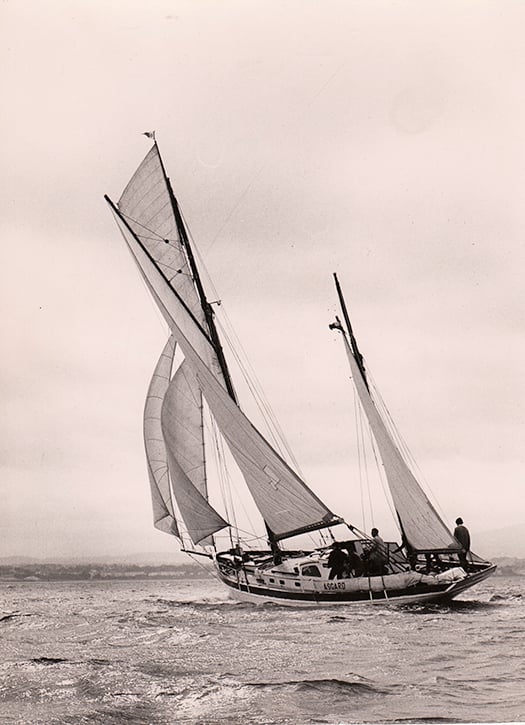
Asgard in her full sail training role in 1970 in Dublin Bay
Asgard was commissioned in her new role in Howth, the scene of her historic gun running in 1914, in the spring of 1969. Under the dedicated command of Captain Eric Healy, the little ship did her very best, but it soon became obvious that her days of active use would be limited by reasons of age, and anyway she was too small to be used for the important sail training vessel roles of providing space to entertain local bigwigs and decision-makers in blazers.
By 1972, the need for a replacement vessel was a matter of growing debate in the sailing community, and during a cruise in West Cork in the summer of 1972, I got talking to Dermot Kennedy of Baltimore out on Cape Clear. Dermot was the man who introduced Glenans to Ireland in 1969, and then he branched out on his own in sail training schools. A man of firm opinions, he reacted with derision to my suggestion that Asgard's replacement should be a modern glassfibre Bermudan ketch, but with enough sails to keep half a dozen trainees busy.
"Nonsense" snorted Dermot. "Ireland needs a real sailing ship, a miniature tall ship maybe, but still a real ship, big enough to carry square rig and have a proper clipper bow and capture the imagination and pride of every Irish person who sets eyes on her. And she should be painted dark green just to show she's the Irish sail training ship, and no doubt about it".
Some time that winter I simply mentioned his suggestions in Afloat magazine, and during the Christmas holidays they were read by Jack Tyrrell at his home in Arklow. During his boyhood, in the school holidays he had sailed with his uncle on the Arklow schooner Lady of Avenel, and it had so shaped his development into the man who was capable of running Ireland's most successful boatyard that he had long dreamed of a modern version of the Lady of Avenel to be Ireland's sail training ship.
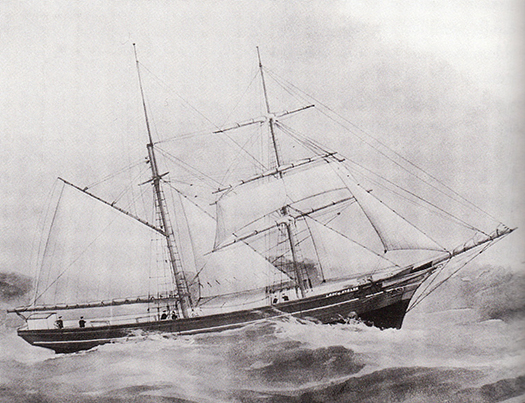
The inspiration – Jack Tyrrell's boyhood experiences aboard Lady of Avenel inspired him to create Ireland's first proper sail training ship
In fact, in 1954 he had sketched out the plans for a 110ft three masted training ship, but Ireland in the 1950s was in the doldrums and the idea got nowhere. Yet the spark was always there, and it was mightily re-kindled by what Dermot Kennedy had said. So at that precise moment, the normal Christmas festivities in the Tyrrell household were over. They'd to continue the celebrations without the head of the family. The great man took himself off down to the little design office in his riverside boatyard, and in clouds of pipe tobacco smoke, he re-drew the lines of the 110ft three master to become an 83ft brigantine, the size reduction meaning that the shop would only need a fulltime crew of five.
Working all hours, he had the proposal drawings finished in time to rejoin his family to see in the New Year. And in the first post after the holiday, we got the drawings at Afloat, and ran them in the February 1973 issue.

Jack Tyrrell's proposal drawings for the new brigantine, as published in the February 1973 Afloat
In Ireland then as now, most politicians had inscribed in their heads the motto: "There's No Votes In Boats". So after Charlie Haughey had fallen from favour with the Arms Trial of 1970, Coiste an Asgard became an orphan. But 1973 brought a new government, and there was one cabinet minister in it who was proud to proclaim his allegiance to the sea.
Unfortunately for the respectability of the maritime movement in Ireland, our supporters in the higher echelons of politics have often tended to be from the colourful end of the political spectrum, whatever about their placing in the left-right continuum. Thus it was that, at mid-morning on St Patrick's Day 1973, I got an ebullient phone call and an immediate announcement, without the caller saying who he was. "Winkie" he bellowed, "That ship is going to be built. I'll make sure of it. I've just made a ministerial decision".
It emerged that it was our very own new Minister for Defence, Patrick Sarsfield Donegan TD. The enthusiasm for the new ship, engendered by studying Jack Tyrrell's drawings, led to a snap decision which stayed decided, and it all happened in the Department for Defence.
However, it was 1981 by the time the ship was launched, and she looked rather different from Jack Tyrrell's preliminary drawings, though the basic hull shape built in timber was the same sweet lines as originally envisaged, so she was able to sail like a witch. But as for her supporters at Government level, the non-stop cabaret continued. Charlie Haughey had regained power, and by 1981 he was Taoiseach. It was he who had seen to it that the Department of Defence continued to look after the Asgard II project with support from another sailing TD who might not have seen eye–to-eye with him on other matters, Bobby Molloy of Galway.
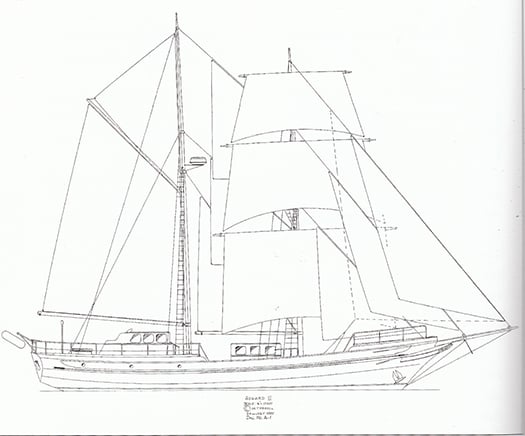
Asgard II in her finished form
So on a March day in 1981, almost exactly twelve years after he'd commissioned the original Asgard in her new role as a sail training vessel, Charlie Haughey took it upon himself to christen the new Asgard II in Arklow basin. And the champagne bottle refused to break. Five or six time he tried, but with no success.
Showing considerable grace under pressure and observed by a large crowd, he quietly took his time undoing all the ribbons and paraphernalia on the big bottle. Then he marched with it up to the new flagship's stem, and hit it a mighty double-handed wallop. The bottle exploded that time, with no mistake. And apart from the usual Haughey growl to those nearby about the idiocy of whoever forgot to score the champagne bottle beforehand, it was all done with the best of humour.
For most of her subsequent career, there's no doubt Asgard was a lucky and very successful vessel. Yet when her demise came, you couldn't help but think of the old notion that if the champagne bottle doesn't break first time, then she'll ultimately be an unlucky ship.
But there are more prosaic explanations. With a limited budget and every penny being scrutinized, Jack Tyrrell and his men had to build Asgard II in fishing boat style, which is fine within its proper time span, but that time span is really only twenty years, maybe thirty if the ship gets extra care. But with her fishing boat hull carrying a demanding brigantine rig, although she always looked immaculate, Asgard II was starting to show her age in the stress areas.
By 2005 there was serious talk about the need to plan for a replacement. When her skipper Colm Newport was told to renew her rig as the original spars were clearly well past it, he meticulously searched the best timber yards at home and abroad and when she got her new rig – it was 2006 or thereabouts – I wrote an only slightly tongue-in-cheek article suggesting that now was the time to replace her old tired wooden hull with a new steel one to the same Jack Tyrrell lines, but utilising the excellent new rig and as many of the fixtures and fittings as were still in good order from the original ship.
To say the response was negative is understating the case. People's attachment to Asgard could only imagine a wooden ship. It was the end of any meaningful debate. So things drifted on, with each new government seemingly even less interested in maritime matters generally, and sail training in particular, than the one before.
In September 2008, Asgard started taking in water while on passage with a crew of trainees towards La Rochelle for a maritime festival following which - while still in La Rochelle – it was planned that she would be lifted out for a thorough three week survey and maintenance programme.

Asgard's accommodation worked superbly whether at sea or in port. But the fact that so much was packed into a relatively small hull meant that some areas were almost inaccessible for proper inspection
It might have been the saving of her. But it was not to be. It's said that it was a failed seacock which caused the catastrophic ingress of water. She was a very crowded little ship, she packed a lot into her 84ft, so some hull fittings were less accessible internally than they would be in a more modern vessel, and may have deteriorated to a dangerous level. But if, as some would propose, she hit something in the water which caused a plank to start, then the fact that nobody aboard was aware of any impact suggests that the time for a major overhaul, and preferably a hull replacement, was long overdue.
The moment Asgard II sank, she ceased to have any future as a sail training vessel, and there was no real official interest in her salvage. You simply cannot take other people's children to sea on a salvaged vessel of doubtful seaworthiness. And as it happens, the sinking came at exactly the time the Irish economy fell of a cliff. So although after an enquiry the Government accepted a €3.8 million insurance settlement, in the end, despite assurances to the contrary, it disappeared into the bottomless pit which was the national debt, and within a year Coiste an Asgard was wound up with its records and few resources incorporated into a new entity, Sail Training Ireland.
The plot takes a further macabre twist in that, shortly after the loss of Asgard II, the Northern Ireland Sailing Training ketch was also lost after hitting a rock on the Antrim coast. From having two popular and well-used sail training vessels in the middle of 2008, within a year Ireland had no official sail training vessels at all.
Yet though the flame had been largely subdued, there were those who have kept the faith, and gradually the sail training movement is being rebuilt. Sail Training Ireland is the frontline representative for around five different organisations, being the official affiliate of Sail Training International, and it has a busy programme of placing trainees in ships which operate at an international level, in which the Dutch are supreme.
In Ireland at the moment, the only sail training "ship" is the schooner Spirit of Oysterhaven, run by Oliver Hart and his team from their adventure centre near Kinsale. In fact, Spirit – you can read about her in Theo Dorgan's evocative book Sailing For Home (Penguin Ireland 2004) – really is punching way above her weight in representing Ireland in a style reminiscent of both the Asgards.
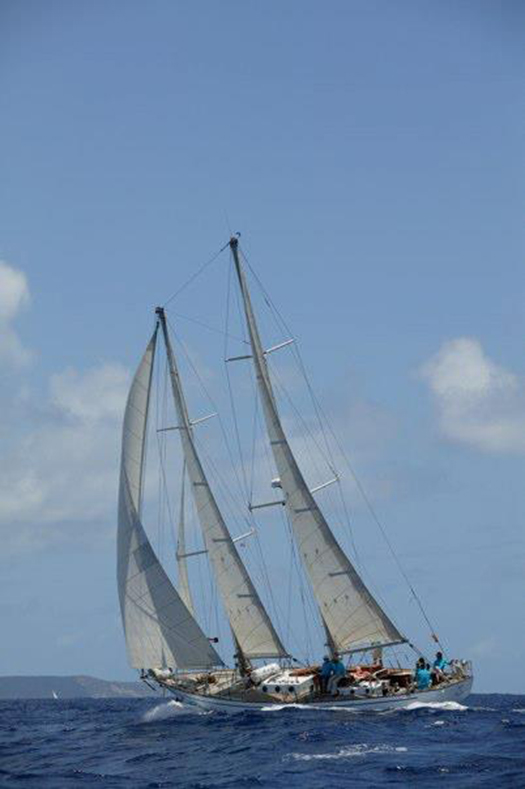
Spirit of Oysterhaven has been doing great work in keeping sail training alive in Ireland
But having the ship is one thing, paying the fees for the trainees to be aboard is something else, and sail training bursaries are one of the key areas of expansion in current maritime development in Ireland. There was an unusual turn to this in 2014 when somebody came up with the bright idea of using Irish Cruising Club funds (which are generated by the surplus from the voluntary production of the club's Sailing Directions) to provide bursaries for youngsters to take part in last summer's ICC 85th Anniversary Cruise-in-Company along the southwestern seaboard on Spirit of Oysterhaven.
The idea worked brilliantly, and this concept of neatly-tailored sail training bursaries is clearly one which can be usefully developed. But still and all, while it's great that young Irish people are being assisted in getting berths aboard charismatic vessels like Europa, the feeling that we should have our own proper sail training ship again is gradually gaining traction, and this is where the Atlantic Youth Trust comes in.
The AYT had its inaugural general meeting in Belfast as recently as the end of September 2014, so it may not yet have come up on your radar. But as it has emerged out of the Pride of Ireland Trust which in turn emerged from the Pride of Galway Trust, you'll have guessed that Enda O'Coineen and John Killeen are much involved, and they've roped in some seriously heavy hitters from both sides of the border, either as Board Members or backers, and sometimes as both.
The cross-border element is central to the concept of building a 40 metre three-masted barquentine, a size which would put her among the glamour girls in Class A, and could carry a decidedly large complement of 40 trainees, even if you're inevitably talking of stratospheric professional crewing costs.
However, by going straight in at top government level on both sides of the border, the AYT team are finding that they're pushing at a door which wants to open, particularly after the new Stormont House agreement was reached in the last days of 2014 to bring a more enthusiastic approach both to cross-community initiatives in the north, and cross border co-operation generally.
Who knows, but if they can succeed in getting cross-community initiatives working in Northern Ireland, then they may even be able to swing some sort of genuine Dublin-Cork shared enthusiasm in the Republic, for I've long thought that one of the factors in holding back many maritime initiatives in Ireland is that, while Dublin may be the political capital, Cork is quietly confident it's the real maritime capital, and does its own thing.
Be that as it may, the AYT have done serious studies, and their conclusion is the best scheme to learn from is the Spirit of Adventure programme in New Zealand. This is where the feeling of going back to the future arises, for in looking at photos of their ship Spirit of New Zealand, there's no escaping the thought that you're looking at Jack Tyrrell's concept ship of 1954 brought superbly to life.

Spirit of New Zealand

Spirit of New Zealand almost seems like a vision of 1954 brought to life...
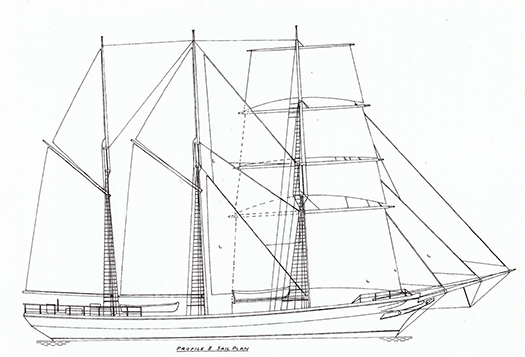
.....and that vision is Jack Tyrrell's 1954 concept for a 110ft sail training ship
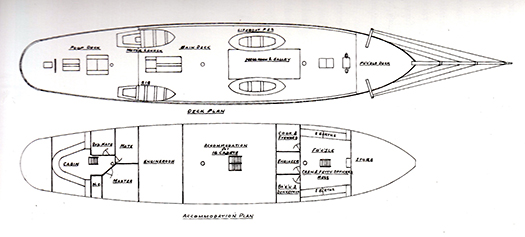
The 1954 accommodation drawings for the 110ft ship hark back to a more rugged age. Imagine the difficulties the ship's cook would face trying to get hot food from his galley on deck amidships all the way back to the officers in their mess down aft
We needn't necessarily agree with all the AYT's basic thinking For instance, they assert that Ireland is like New Zealand is being an isolated smallish island. It depends what you mean by "isolated". Those early sail training pioneers, the Vikings, certainly didn't think of Ireland as isolated. They thought it was central to the entire business of sailing up and down Europe's coastline.
Thus any all-Ireland sail training vessel would be expected to be away abroad at least as much as she'd be at home, whereas Spirit of New Zealand is usually home – the season of 2013-2014 was the first time she'd been to Australia since 1988, when she was in the fleet with Asgard II for the First Feet celebrations.
In New Zealand, she's a sort of floating adventure centre, and a large tender often accompanies her to take the trainees to the nearest landing place for shoreside adventures, for it's quite a challenge keeping 40 energetic young people fully occupied.
In Europe, that's where the sail training races come in. Time was when the racing aspect was down-played. But there's nothing like a good race to bring a mutinous crew together, and the recently-published mega-book about the world's sail training vessels, Tall Ships Today by Nigel Rowe of Sail Training International, quite rightly devotes significant space to everything to do with the racing.
Thus if we do get a new sail training ship for Ireland, she'll have to sail well and fast. That was Asgard II's greatest virtue. For there is nothing more dispiriting for troubled young folk than to find themselves shackled to the woofer of the fleet. Yet you'd be pleasantly surprised by how previously disengaged youngster can become actively and enthusiastically involved when they find that they're being transformed from scared and seasick kids into members of a winning crew.
So now, the 64 thousand dollar question. The cost. It's rather more than 64 thousand. AYT reckon they'll have to come up with a final capital expenditure of €15 million to build the ship and get her into full commission with proper crewing and shoreside administration arrangements in place. But after that – and here's the kernel of the whole concept – they reckon that the running costs will come out of existing government expenditure already in place and used every year for education, youth training, sporting facilities, social development and so forth.
So their pitch is that if the governments north and south come up with funding to support substantial donations already proposed for AYT by various benevolent national and international bodies, then once the ship is in being, she will generate her own income in the same way as vessels like Europa and Morgen Stern are already doing in mainland Europe.
And it's to the heart of mainland Europe that they'll be looking for design and contruction, as it's the Dykstra partnership which will be overseeing the design, and their ship-build associate company Damen will likely do the construction work, though one idea being floated is that Damen might provide a flatpack kit for the vessel to be built in steel in Ireland.
Those of us who dream of Asgard II being built anew will find all this a bit challenging to take on board. My own hopes, for instance, would still be to build Asgard II again to Jack Tyrrell's lines, but with the hull constructed in aluminium. It would be expensive as it would need to be double-skin below the waterline, but the ship's size would be very manageable with a professional crew of just five, while she'd sail like a dream And proper top-class marine grade aluminium seems to last for ever, as naval architect Gerry Dijkstra (his surname is slightly different from that of the partnership) himself shows with his remarkable cruises with his own-designed alloy 54-footer Bestevaer.
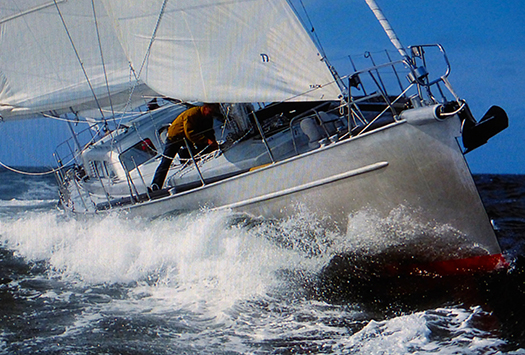
A man who knows what he's doing. This is Gerry Dijkstra's own extensively-cruised alloy-built 54 footer Bestevaer. The name translates not as "Best ever", but either as "best father" or "best seafarer", and was the name of affection given to the great Admiral de Ruyter by his loyal crews
Whatever, the good news is that things are on the move, and we wish them well, all those who have kept the Irish sail training flame alive through some appalling setbacks. Now, it really is the time to move forward. And if we do get a new ship, why not call her the Jack Tyrrell? He, of all people, was the one who kept the faith and the flame alive.
- Tall ship
- Belfast
- Jack Tyrell
- Kristiansand
- Aalesund
- Titanic
- maritime
- Class A
- square riggers
- George Stage
- Alexander Von Humboldt
- Christian Radich
- Sorlandet
- Shtandart
- Brigantine
- Asgard II
- Elaine Byrne
- Erskine Childers
- Sean Flood
- Naval
- Afloat magazine
- boatyard
- sail training ship
- Coiste an Asgard
- Charlie Haughey
- Colm Newport
- Irish Cruising Club
- Spirit of Oysterhaven
- Enda O'Coineen
- John Killeen
- Dykstra
Last of the Tall Ships Finally Departs Dublin Port
#TALL SHIPS – It has been more than a fortnight ago since the spectacle of Dublin Tall Ships Race Festival's 'Parade of Sail' took place, and today the last participant, the Swedish Navy's Falken, made a southbound departure of Dublin Bay, writes Jehan Ashmore.
The last large tallship to depart the festival was the Italian Navy's Amerigo Vespucci, leaving the smaller Swedish gaff schooner to remain moored along the Liffey quays until her departure this afternoon. The B-class tallship built in 1947, is based out of Karlskrona and her crew of 13 officers and 29 trainees are currently heading for Porto.
It is ironic that on the same day of Falken's farewell, the Norwegian tallship Christian Radich is currently heading northbound in the Irish Sea as previously reported today. She is to visit the capital, where she called last year to publicise in advance this year's Tall Ships Race Festival.
Norwegian School Tallship to Make Return Call to Capital
#TALL SHIP -The Norwegian three-mast school ship Christian Radich is to visit Dublin Port tomorrow as part of a four-day stopover, writes Jehan Ashmore.
The 1937 built tallship will make her main port of call to the capital during a four week sailing programme arranged by Norwegian Navy Officer Candidate School.
She called to Dublin Port last year, as previously reported on Afloat.ie for publicity purposes in advance of this year's successful festival in the capital which was host to the final port of call of the Tall Ships Races. Likewise of the tallships, she is to berth alongside the Liffey at Sir John Rogersons Quay.
For further details of the tallship whose homeport is Oslo and also the principle characteristics of the vessel click this LINK.
Norway's Oldest A-Class Tallship Sets Sail for Dublin
STV Statsraad Lehmkuhl is scheduled to arrive in Dublin Bay on Thursday afternoon where she will enter through the port's East-Link lift toll-bridge and berth at Sir John Rogerson's Quay. She departed Bergen last Thursday and is currently heading for Stornoway on the Isle of Lewis.
She was originally christened Grossherzog Fridrich August when completed at the J.C. Tecklenborgwerft yard in Bremerhaven as a sail training ship for the German merchant navy.
In 1923 she changed hands and began a career with the Norwegian Shipowners Association on the initiative of the state Kritoffer Lehmkuhl. The vessel was renamed in his honour due to Lehmkuhl's dedication to the cause of cadetship programmes and his contribution in creating an independent Norwegian government in 1905.
She was transferred to the Bergen Schoolship Association in 1924. After many years serving the association the vessel was donated in 1978 to the Statsraad Lehmkuhl Foundation, an organisation also based in the country's second largest city.
100 Days to Waterford's Tall-Ships Festival
is to draw 500,000 visitors from home and abroad. The festival is to be presented by Szczecin and organised by the Sail Training International.
Over 70 of the worlds tall-ships of all shapes and sizes will sail up the River Suir to take up residence on both sides of Waterford's city centre quays, where a major meeting of over 1,500 trainee sailors stretching from far and distant shores are to congregate.
One of the attending Class 'A' fully rigged ships, Christian Radich, which was built in 1937, incidentally provided sail-training opportunities for Irish trainees in an arrangement between her Norwegian owners and Coiste an Asgard. The sail-trainee agreement in 2009 followed the sinking of Coiste an Asgard's brigantine the Asgard II in the previous year. This was to be the last season of the state-owned sail training agency which was axed in the 2009 budget.
Another 'A' lister is the UK flagged Royalist, a brig built by Groves and Gutteridge in Cowes, Isle of Wight to a design by Colin Mudie. The 40 year old brig was named by HRH Princess Anne in 1971 for the Sea Cadet Association. She may be small for an 'A' class at just 28-metres long but the vessel can easily be spotted with her distinctive black and white painted hull.
While one of the oldest vessels to participant is the 87 year-old Brixham built trawler Provident, which along with Leader, are the only 'sailing' survivors of a once numerous traditional North Sea fishing craft. The 95-foot vessel was built at Galmpton on the River Dart. In 1991 there was a major refit of the 85 tonnes craft which has since 1999 worked from Brixham as part of the Trinity Sailing Foundation.
The event which is billed as the largest Irish festival in 2011 also presents young Irish people to experience a once in a lifetime opportunity to set sail onboard a tall-ship. The opportunity is open to those aged 16 or over by June 30 and are fit and active to be a trainee on the inaugural race leg from Waterford to Greenock (departing 3 July). For details click here.
On this date the eagerly awaited 'Parade of Sail' is set to depart the crystal city downriver on the Waterford Estuary and out into the open sea.
Looking for further reading on Tall Ships in Ireland? Click the links below:
Click this link to read all our Tall Ships Stories on one handy page
Previewing Ireland's Tall Ships 2011 Season
Can Ireland Get a New Tall Ship?
Setting Sails for Waterford's Tall Ships Race
The four-day maritime spectacle expects to attract 500,000 visitors to throng the quays of the 'Crystal' city. Presented by Szczecin and organised by Sail Training International, the prestigious event is supported through host-port partners, 3, Bulmers Original Irish Cider and Waterford Crystal. In addition the host-port educational partner is Waterford Institute of Technology and the official media partner covering the event is RTE. Between them over €450,000 has been raised to support funding.
Waterford City Council and the Port of Waterford are providing leading roles as delivering agencies having jointly mounted the bid to secure staging the Tall Ships Races return following the city's successful hosting of the event in 2005.
Notably in that year's 'Parade of Sail' the procession was led by Asgard II, followed astern by Jeanie Johnston and Dunbrody. The involvement of all Irish tall-ships was an historical occasion particularly in view of the sinking of Asgard II three years later.
In 2005, Waterford also claimed to be the first Irish host port to be the starting port for the race and this will be repeated in 2011.

Gary Breen, Failte Ireland; Cllr Mary Roche,Mayor of Waterford,David McCoy, House of Waterford Crystal and Des Whelan, Chairman, The Tall Ships Races 2011 onboard the 'Lord Nelson' in Waterford. Photo: Dylan Vaughan
At the reception onboard Lord Nelson, Cllr Mary Roche, Mayor of Waterford said: "To 3,Bulmers,RTE, Waterford Crystal and Waterford Institute of Technology, I say a very sincere thank you on behalf of the people of Waterford and all of those around Europe and beyond who will be here next summer for what promises to be four magical days of free fun in Ireland's oldest city".
Next year's hosting is also to be supported by Failte Ireland which is allocating resources of €3m while Tourism Ireland will embark on an intensive marketing campaign during the mid summer event, which is billed to be the biggest event in Ireland.
There will be between 80-100 tall-ships and their international crews converging in Waterford. Among the vessels confirmed is the 1937-built, Christian Radich which starred in the 1958 film, The Windjammer and also featured in the 1970's television series, The Onedin Line.
Incidentally the Christian Radich was used, albeit with limited trainee spaces allocated to Coist an Asgard in an arrangement with the vessel's Norwegian owners in 2009, the first full year of the national sail training programme since the sinking of Asgard II the previous year.
The staging costs of the 2011 Tall Ships is estimated at €3.5m and is expected to generate €35m to Waterford City and hinterland. The organisers of the event will be embracing social technology communications networks with presentations on Facebook, Twitter and other servers.
Last year Belfast held the honour in welcoming the finale of the Tall Ship Races, incorporating the Tall Ships Atlantic Challenge. Dublin hosted the event in 1998, albeit the race was then known as the Cutty Sark Tall Ships Race with this same title applying to the race when the event visited Cork Harbour in 1991.
Looking for further reading on Tall Ships in Ireland? Click the links below:
Click this link to read all our Tall Ships Stories on one handy page
Previewing Ireland's Tall Ships 2011 Season
Can Ireland Get a New Tall Ship?





























